Critical Review of Nursing Practice and Decision Making: Mr. Raju
VerifiedAdded on 2022/08/20
|14
|4547
|17
Essay
AI Summary
This essay critically reviews nursing practice and decision-making, focusing on a case study involving Mr. Raju, a 56-year-old patient with acute chest pain and a history of hypertension, type 2 diabetes, hyperlipidemia, anxiety, and depression, diagnosed with Acute Coronary Syndrome and bipolar disorder. The essay explores the application of the biopsychosocial model in assessing the patient's needs, including biological, psychological, and social factors. It examines the effectiveness of shared decision-making, community services, and the role of nurses in evaluating care plans. The analysis covers relevant concepts of assessment, planning, and delivery of care, emphasizing the use of national and professional guidelines for clinical decision-making. The essay highlights the importance of addressing both the physical and mental health aspects of the patient's condition, including the need for dual antiplatelet therapy and interventions to manage his smoking habit and stress, providing a comprehensive overview of the patient's care journey and the critical role of nurses in improving patient outcomes. The essay references various studies and guidelines to support the discussion, providing a detailed analysis of patient care.
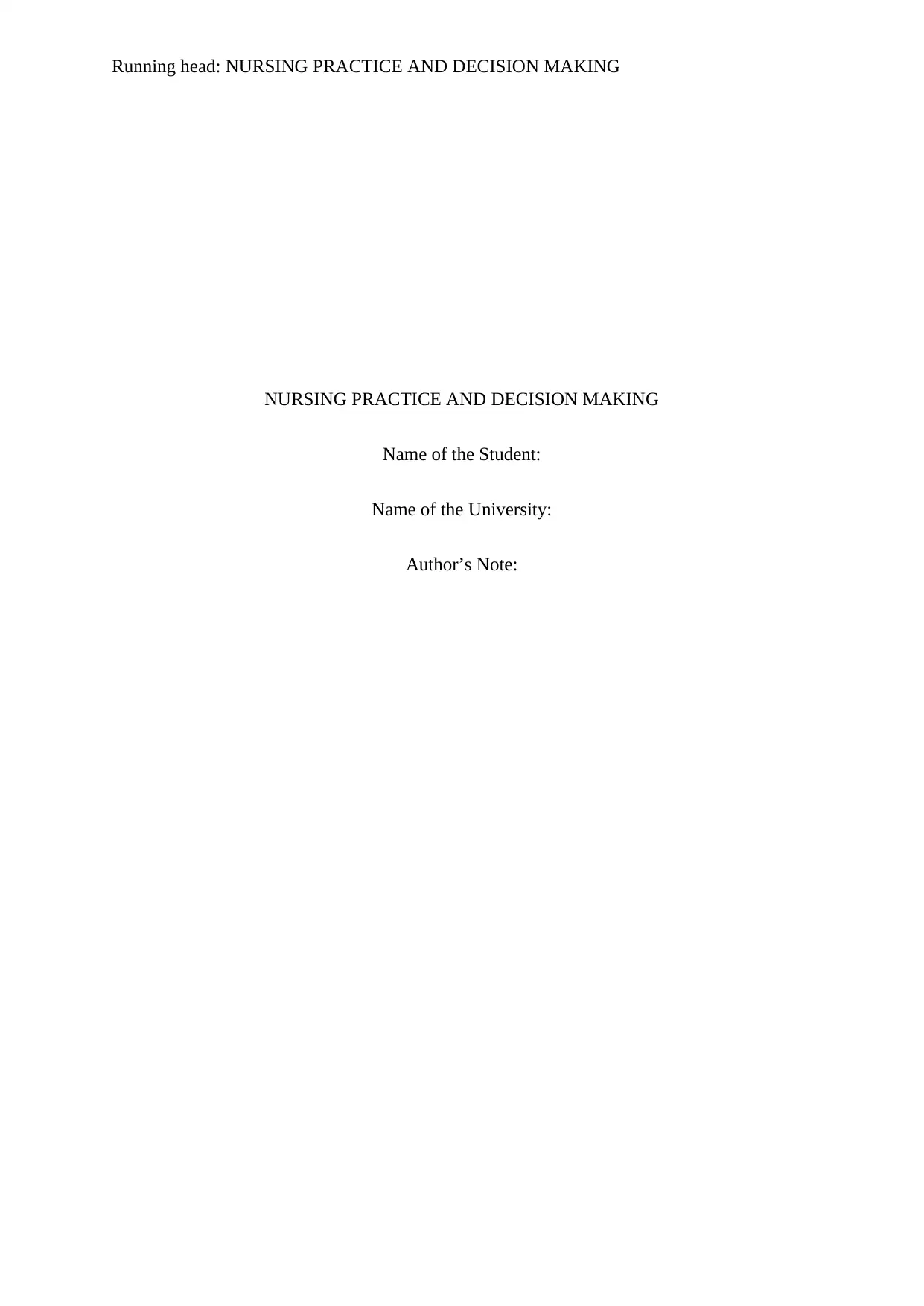
Running head: NURSING PRACTICE AND DECISION MAKING
NURSING PRACTICE AND DECISION MAKING
Name of the Student:
Name of the University:
Author’s Note:
NURSING PRACTICE AND DECISION MAKING
Name of the Student:
Name of the University:
Author’s Note:
Paraphrase This Document
Need a fresh take? Get an instant paraphrase of this document with our AI Paraphraser
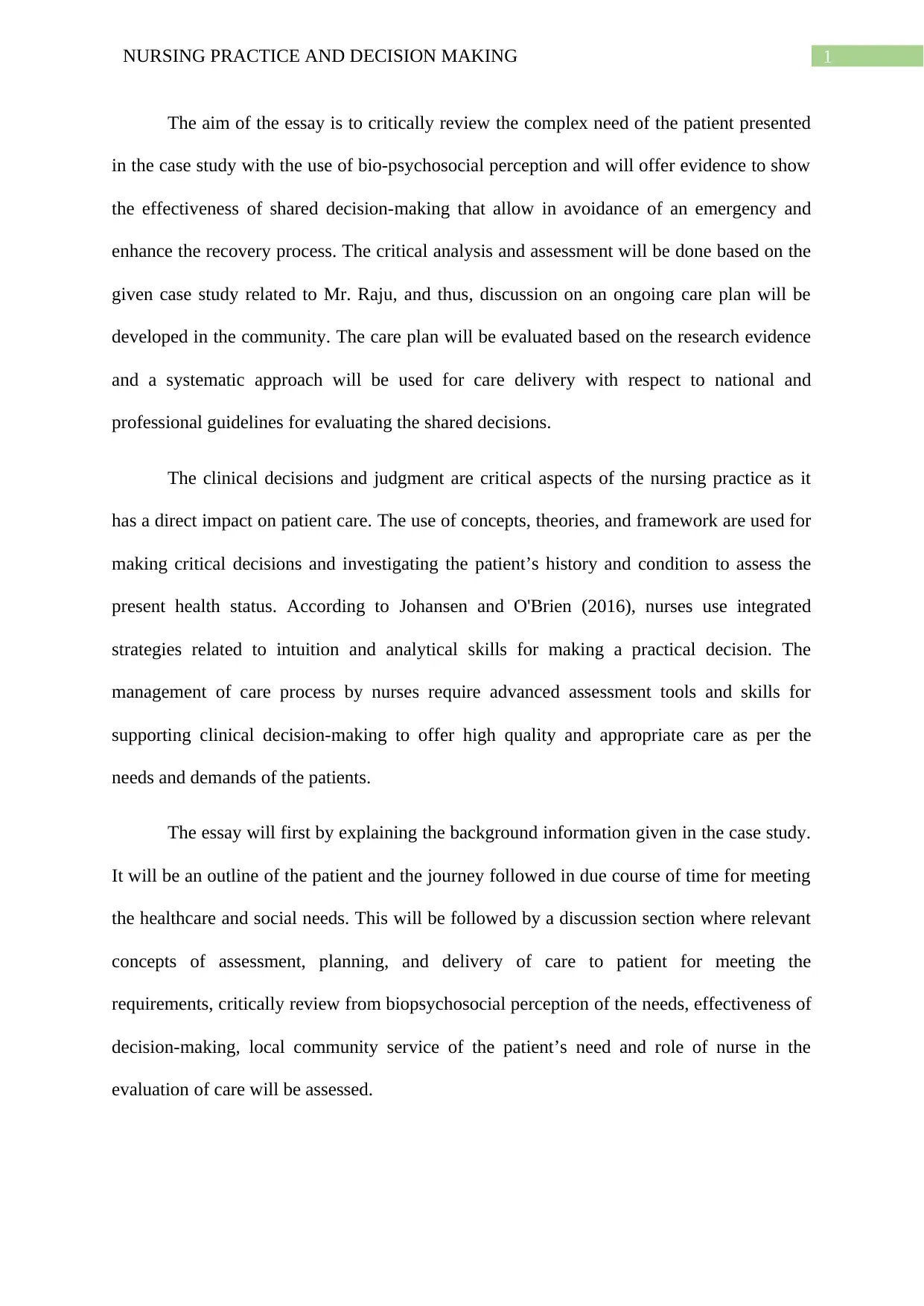
1NURSING PRACTICE AND DECISION MAKING
The aim of the essay is to critically review the complex need of the patient presented
in the case study with the use of bio-psychosocial perception and will offer evidence to show
the effectiveness of shared decision-making that allow in avoidance of an emergency and
enhance the recovery process. The critical analysis and assessment will be done based on the
given case study related to Mr. Raju, and thus, discussion on an ongoing care plan will be
developed in the community. The care plan will be evaluated based on the research evidence
and a systematic approach will be used for care delivery with respect to national and
professional guidelines for evaluating the shared decisions.
The clinical decisions and judgment are critical aspects of the nursing practice as it
has a direct impact on patient care. The use of concepts, theories, and framework are used for
making critical decisions and investigating the patient’s history and condition to assess the
present health status. According to Johansen and O'Brien (2016), nurses use integrated
strategies related to intuition and analytical skills for making a practical decision. The
management of care process by nurses require advanced assessment tools and skills for
supporting clinical decision-making to offer high quality and appropriate care as per the
needs and demands of the patients.
The essay will first by explaining the background information given in the case study.
It will be an outline of the patient and the journey followed in due course of time for meeting
the healthcare and social needs. This will be followed by a discussion section where relevant
concepts of assessment, planning, and delivery of care to patient for meeting the
requirements, critically review from biopsychosocial perception of the needs, effectiveness of
decision-making, local community service of the patient’s need and role of nurse in the
evaluation of care will be assessed.
The aim of the essay is to critically review the complex need of the patient presented
in the case study with the use of bio-psychosocial perception and will offer evidence to show
the effectiveness of shared decision-making that allow in avoidance of an emergency and
enhance the recovery process. The critical analysis and assessment will be done based on the
given case study related to Mr. Raju, and thus, discussion on an ongoing care plan will be
developed in the community. The care plan will be evaluated based on the research evidence
and a systematic approach will be used for care delivery with respect to national and
professional guidelines for evaluating the shared decisions.
The clinical decisions and judgment are critical aspects of the nursing practice as it
has a direct impact on patient care. The use of concepts, theories, and framework are used for
making critical decisions and investigating the patient’s history and condition to assess the
present health status. According to Johansen and O'Brien (2016), nurses use integrated
strategies related to intuition and analytical skills for making a practical decision. The
management of care process by nurses require advanced assessment tools and skills for
supporting clinical decision-making to offer high quality and appropriate care as per the
needs and demands of the patients.
The essay will first by explaining the background information given in the case study.
It will be an outline of the patient and the journey followed in due course of time for meeting
the healthcare and social needs. This will be followed by a discussion section where relevant
concepts of assessment, planning, and delivery of care to patient for meeting the
requirements, critically review from biopsychosocial perception of the needs, effectiveness of
decision-making, local community service of the patient’s need and role of nurse in the
evaluation of care will be assessed.
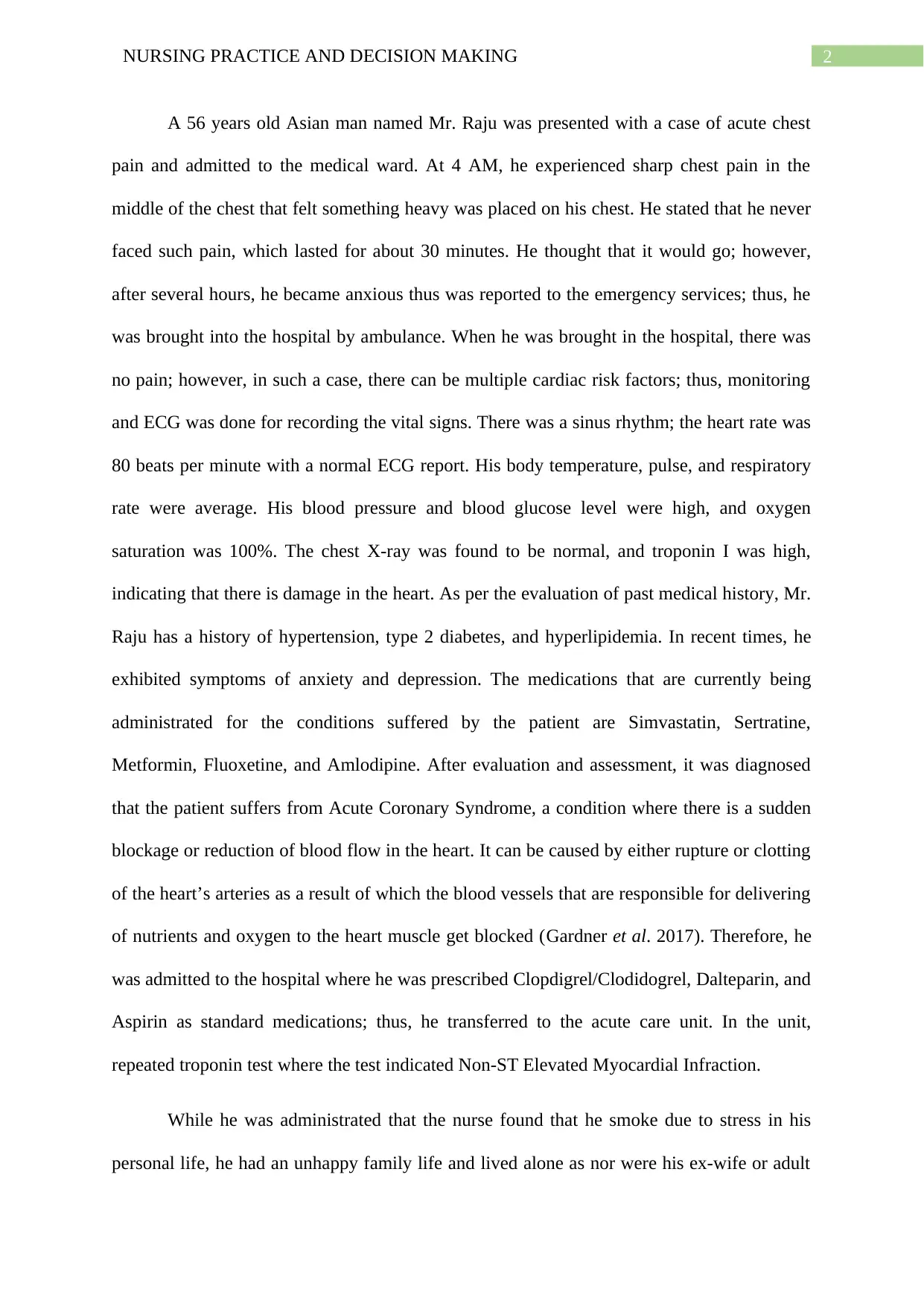
2NURSING PRACTICE AND DECISION MAKING
A 56 years old Asian man named Mr. Raju was presented with a case of acute chest
pain and admitted to the medical ward. At 4 AM, he experienced sharp chest pain in the
middle of the chest that felt something heavy was placed on his chest. He stated that he never
faced such pain, which lasted for about 30 minutes. He thought that it would go; however,
after several hours, he became anxious thus was reported to the emergency services; thus, he
was brought into the hospital by ambulance. When he was brought in the hospital, there was
no pain; however, in such a case, there can be multiple cardiac risk factors; thus, monitoring
and ECG was done for recording the vital signs. There was a sinus rhythm; the heart rate was
80 beats per minute with a normal ECG report. His body temperature, pulse, and respiratory
rate were average. His blood pressure and blood glucose level were high, and oxygen
saturation was 100%. The chest X-ray was found to be normal, and troponin I was high,
indicating that there is damage in the heart. As per the evaluation of past medical history, Mr.
Raju has a history of hypertension, type 2 diabetes, and hyperlipidemia. In recent times, he
exhibited symptoms of anxiety and depression. The medications that are currently being
administrated for the conditions suffered by the patient are Simvastatin, Sertratine,
Metformin, Fluoxetine, and Amlodipine. After evaluation and assessment, it was diagnosed
that the patient suffers from Acute Coronary Syndrome, a condition where there is a sudden
blockage or reduction of blood flow in the heart. It can be caused by either rupture or clotting
of the heart’s arteries as a result of which the blood vessels that are responsible for delivering
of nutrients and oxygen to the heart muscle get blocked (Gardner et al. 2017). Therefore, he
was admitted to the hospital where he was prescribed Clopdigrel/Clodidogrel, Dalteparin, and
Aspirin as standard medications; thus, he transferred to the acute care unit. In the unit,
repeated troponin test where the test indicated Non-ST Elevated Myocardial Infraction.
While he was administrated that the nurse found that he smoke due to stress in his
personal life, he had an unhappy family life and lived alone as nor were his ex-wife or adult
A 56 years old Asian man named Mr. Raju was presented with a case of acute chest
pain and admitted to the medical ward. At 4 AM, he experienced sharp chest pain in the
middle of the chest that felt something heavy was placed on his chest. He stated that he never
faced such pain, which lasted for about 30 minutes. He thought that it would go; however,
after several hours, he became anxious thus was reported to the emergency services; thus, he
was brought into the hospital by ambulance. When he was brought in the hospital, there was
no pain; however, in such a case, there can be multiple cardiac risk factors; thus, monitoring
and ECG was done for recording the vital signs. There was a sinus rhythm; the heart rate was
80 beats per minute with a normal ECG report. His body temperature, pulse, and respiratory
rate were average. His blood pressure and blood glucose level were high, and oxygen
saturation was 100%. The chest X-ray was found to be normal, and troponin I was high,
indicating that there is damage in the heart. As per the evaluation of past medical history, Mr.
Raju has a history of hypertension, type 2 diabetes, and hyperlipidemia. In recent times, he
exhibited symptoms of anxiety and depression. The medications that are currently being
administrated for the conditions suffered by the patient are Simvastatin, Sertratine,
Metformin, Fluoxetine, and Amlodipine. After evaluation and assessment, it was diagnosed
that the patient suffers from Acute Coronary Syndrome, a condition where there is a sudden
blockage or reduction of blood flow in the heart. It can be caused by either rupture or clotting
of the heart’s arteries as a result of which the blood vessels that are responsible for delivering
of nutrients and oxygen to the heart muscle get blocked (Gardner et al. 2017). Therefore, he
was admitted to the hospital where he was prescribed Clopdigrel/Clodidogrel, Dalteparin, and
Aspirin as standard medications; thus, he transferred to the acute care unit. In the unit,
repeated troponin test where the test indicated Non-ST Elevated Myocardial Infraction.
While he was administrated that the nurse found that he smoke due to stress in his
personal life, he had an unhappy family life and lived alone as nor were his ex-wife or adult
⊘ This is a preview!⊘
Do you want full access?
Subscribe today to unlock all pages.

Trusted by 1+ million students worldwide
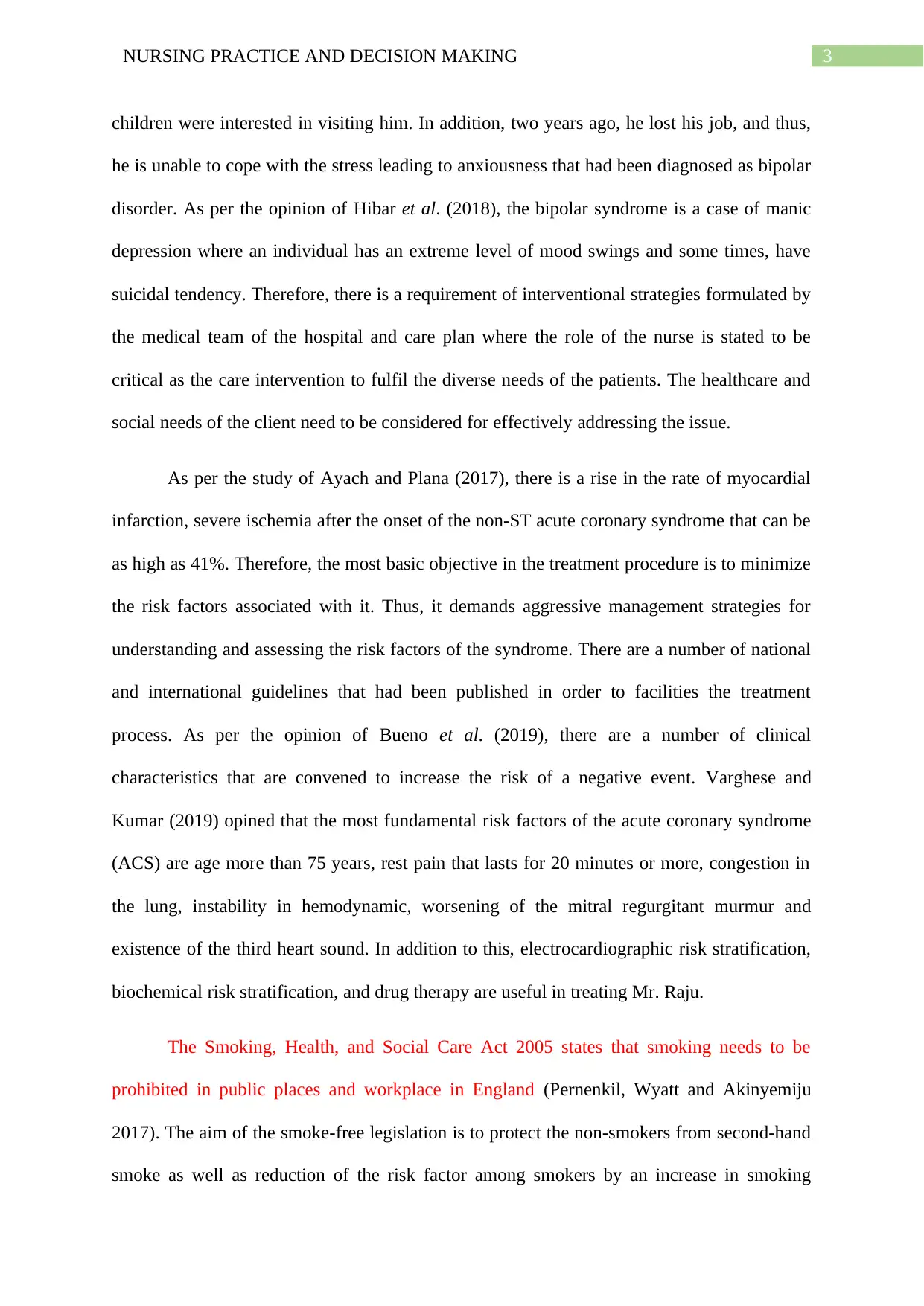
3NURSING PRACTICE AND DECISION MAKING
children were interested in visiting him. In addition, two years ago, he lost his job, and thus,
he is unable to cope with the stress leading to anxiousness that had been diagnosed as bipolar
disorder. As per the opinion of Hibar et al. (2018), the bipolar syndrome is a case of manic
depression where an individual has an extreme level of mood swings and some times, have
suicidal tendency. Therefore, there is a requirement of interventional strategies formulated by
the medical team of the hospital and care plan where the role of the nurse is stated to be
critical as the care intervention to fulfil the diverse needs of the patients. The healthcare and
social needs of the client need to be considered for effectively addressing the issue.
As per the study of Ayach and Plana (2017), there is a rise in the rate of myocardial
infarction, severe ischemia after the onset of the non-ST acute coronary syndrome that can be
as high as 41%. Therefore, the most basic objective in the treatment procedure is to minimize
the risk factors associated with it. Thus, it demands aggressive management strategies for
understanding and assessing the risk factors of the syndrome. There are a number of national
and international guidelines that had been published in order to facilities the treatment
process. As per the opinion of Bueno et al. (2019), there are a number of clinical
characteristics that are convened to increase the risk of a negative event. Varghese and
Kumar (2019) opined that the most fundamental risk factors of the acute coronary syndrome
(ACS) are age more than 75 years, rest pain that lasts for 20 minutes or more, congestion in
the lung, instability in hemodynamic, worsening of the mitral regurgitant murmur and
existence of the third heart sound. In addition to this, electrocardiographic risk stratification,
biochemical risk stratification, and drug therapy are useful in treating Mr. Raju.
The Smoking, Health, and Social Care Act 2005 states that smoking needs to be
prohibited in public places and workplace in England (Pernenkil, Wyatt and Akinyemiju
2017). The aim of the smoke-free legislation is to protect the non-smokers from second-hand
smoke as well as reduction of the risk factor among smokers by an increase in smoking
children were interested in visiting him. In addition, two years ago, he lost his job, and thus,
he is unable to cope with the stress leading to anxiousness that had been diagnosed as bipolar
disorder. As per the opinion of Hibar et al. (2018), the bipolar syndrome is a case of manic
depression where an individual has an extreme level of mood swings and some times, have
suicidal tendency. Therefore, there is a requirement of interventional strategies formulated by
the medical team of the hospital and care plan where the role of the nurse is stated to be
critical as the care intervention to fulfil the diverse needs of the patients. The healthcare and
social needs of the client need to be considered for effectively addressing the issue.
As per the study of Ayach and Plana (2017), there is a rise in the rate of myocardial
infarction, severe ischemia after the onset of the non-ST acute coronary syndrome that can be
as high as 41%. Therefore, the most basic objective in the treatment procedure is to minimize
the risk factors associated with it. Thus, it demands aggressive management strategies for
understanding and assessing the risk factors of the syndrome. There are a number of national
and international guidelines that had been published in order to facilities the treatment
process. As per the opinion of Bueno et al. (2019), there are a number of clinical
characteristics that are convened to increase the risk of a negative event. Varghese and
Kumar (2019) opined that the most fundamental risk factors of the acute coronary syndrome
(ACS) are age more than 75 years, rest pain that lasts for 20 minutes or more, congestion in
the lung, instability in hemodynamic, worsening of the mitral regurgitant murmur and
existence of the third heart sound. In addition to this, electrocardiographic risk stratification,
biochemical risk stratification, and drug therapy are useful in treating Mr. Raju.
The Smoking, Health, and Social Care Act 2005 states that smoking needs to be
prohibited in public places and workplace in England (Pernenkil, Wyatt and Akinyemiju
2017). The aim of the smoke-free legislation is to protect the non-smokers from second-hand
smoke as well as reduction of the risk factor among smokers by an increase in smoking
Paraphrase This Document
Need a fresh take? Get an instant paraphrase of this document with our AI Paraphraser
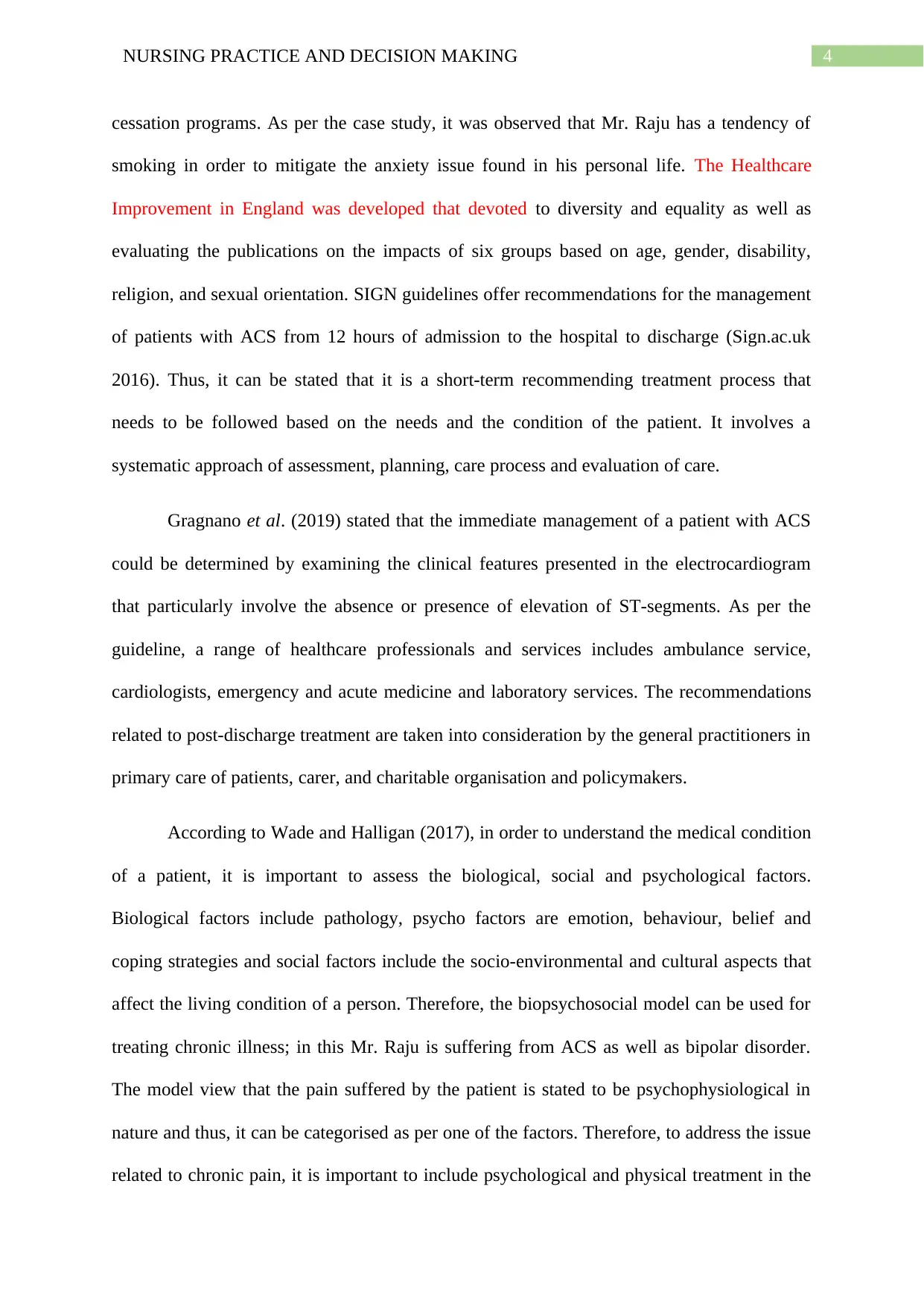
4NURSING PRACTICE AND DECISION MAKING
cessation programs. As per the case study, it was observed that Mr. Raju has a tendency of
smoking in order to mitigate the anxiety issue found in his personal life. The Healthcare
Improvement in England was developed that devoted to diversity and equality as well as
evaluating the publications on the impacts of six groups based on age, gender, disability,
religion, and sexual orientation. SIGN guidelines offer recommendations for the management
of patients with ACS from 12 hours of admission to the hospital to discharge (Sign.ac.uk
2016). Thus, it can be stated that it is a short-term recommending treatment process that
needs to be followed based on the needs and the condition of the patient. It involves a
systematic approach of assessment, planning, care process and evaluation of care.
Gragnano et al. (2019) stated that the immediate management of a patient with ACS
could be determined by examining the clinical features presented in the electrocardiogram
that particularly involve the absence or presence of elevation of ST-segments. As per the
guideline, a range of healthcare professionals and services includes ambulance service,
cardiologists, emergency and acute medicine and laboratory services. The recommendations
related to post-discharge treatment are taken into consideration by the general practitioners in
primary care of patients, carer, and charitable organisation and policymakers.
According to Wade and Halligan (2017), in order to understand the medical condition
of a patient, it is important to assess the biological, social and psychological factors.
Biological factors include pathology, psycho factors are emotion, behaviour, belief and
coping strategies and social factors include the socio-environmental and cultural aspects that
affect the living condition of a person. Therefore, the biopsychosocial model can be used for
treating chronic illness; in this Mr. Raju is suffering from ACS as well as bipolar disorder.
The model view that the pain suffered by the patient is stated to be psychophysiological in
nature and thus, it can be categorised as per one of the factors. Therefore, to address the issue
related to chronic pain, it is important to include psychological and physical treatment in the
cessation programs. As per the case study, it was observed that Mr. Raju has a tendency of
smoking in order to mitigate the anxiety issue found in his personal life. The Healthcare
Improvement in England was developed that devoted to diversity and equality as well as
evaluating the publications on the impacts of six groups based on age, gender, disability,
religion, and sexual orientation. SIGN guidelines offer recommendations for the management
of patients with ACS from 12 hours of admission to the hospital to discharge (Sign.ac.uk
2016). Thus, it can be stated that it is a short-term recommending treatment process that
needs to be followed based on the needs and the condition of the patient. It involves a
systematic approach of assessment, planning, care process and evaluation of care.
Gragnano et al. (2019) stated that the immediate management of a patient with ACS
could be determined by examining the clinical features presented in the electrocardiogram
that particularly involve the absence or presence of elevation of ST-segments. As per the
guideline, a range of healthcare professionals and services includes ambulance service,
cardiologists, emergency and acute medicine and laboratory services. The recommendations
related to post-discharge treatment are taken into consideration by the general practitioners in
primary care of patients, carer, and charitable organisation and policymakers.
According to Wade and Halligan (2017), in order to understand the medical condition
of a patient, it is important to assess the biological, social and psychological factors.
Biological factors include pathology, psycho factors are emotion, behaviour, belief and
coping strategies and social factors include the socio-environmental and cultural aspects that
affect the living condition of a person. Therefore, the biopsychosocial model can be used for
treating chronic illness; in this Mr. Raju is suffering from ACS as well as bipolar disorder.
The model view that the pain suffered by the patient is stated to be psychophysiological in
nature and thus, it can be categorised as per one of the factors. Therefore, to address the issue
related to chronic pain, it is important to include psychological and physical treatment in the
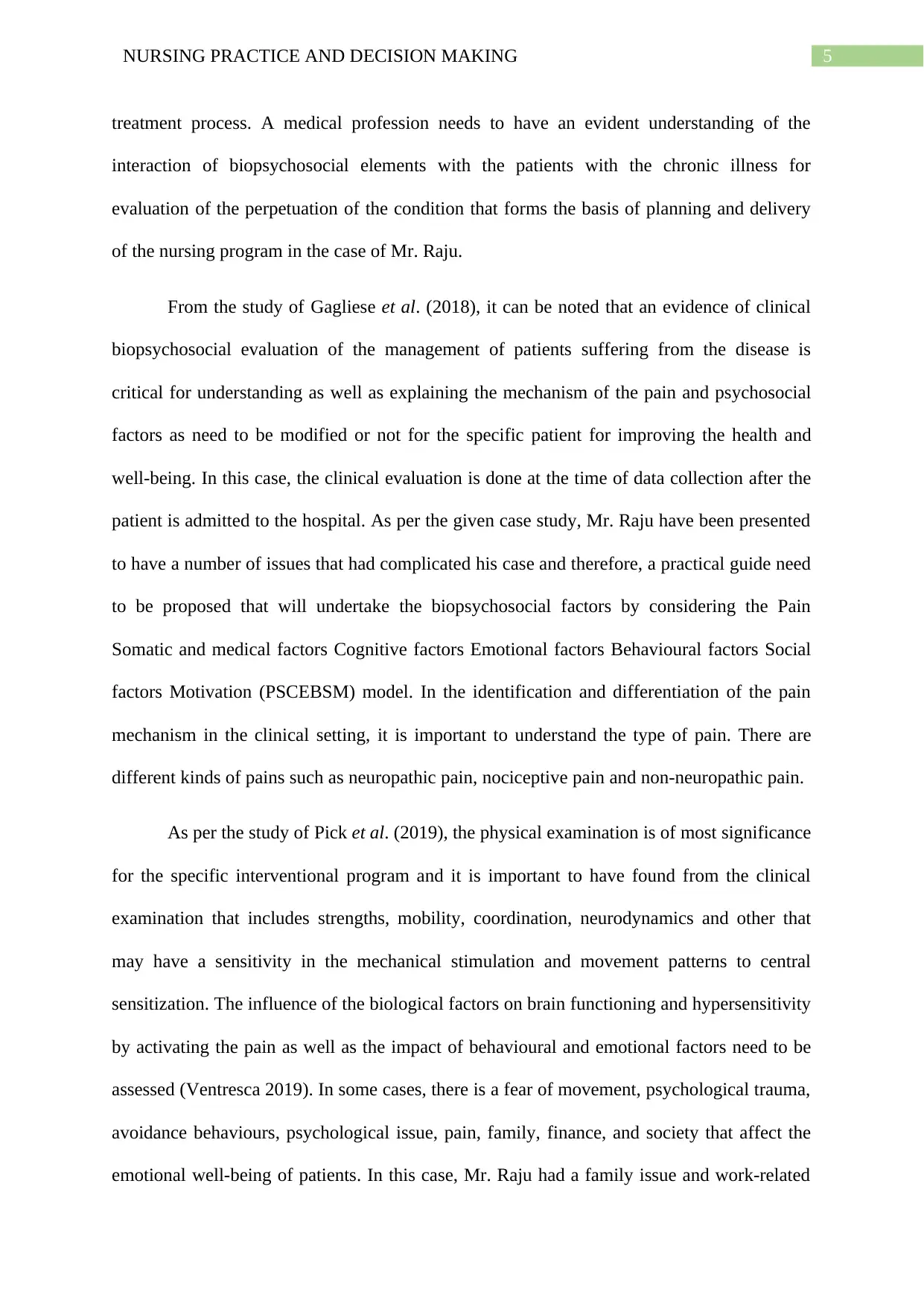
5NURSING PRACTICE AND DECISION MAKING
treatment process. A medical profession needs to have an evident understanding of the
interaction of biopsychosocial elements with the patients with the chronic illness for
evaluation of the perpetuation of the condition that forms the basis of planning and delivery
of the nursing program in the case of Mr. Raju.
From the study of Gagliese et al. (2018), it can be noted that an evidence of clinical
biopsychosocial evaluation of the management of patients suffering from the disease is
critical for understanding as well as explaining the mechanism of the pain and psychosocial
factors as need to be modified or not for the specific patient for improving the health and
well-being. In this case, the clinical evaluation is done at the time of data collection after the
patient is admitted to the hospital. As per the given case study, Mr. Raju have been presented
to have a number of issues that had complicated his case and therefore, a practical guide need
to be proposed that will undertake the biopsychosocial factors by considering the Pain
Somatic and medical factors Cognitive factors Emotional factors Behavioural factors Social
factors Motivation (PSCEBSM) model. In the identification and differentiation of the pain
mechanism in the clinical setting, it is important to understand the type of pain. There are
different kinds of pains such as neuropathic pain, nociceptive pain and non-neuropathic pain.
As per the study of Pick et al. (2019), the physical examination is of most significance
for the specific interventional program and it is important to have found from the clinical
examination that includes strengths, mobility, coordination, neurodynamics and other that
may have a sensitivity in the mechanical stimulation and movement patterns to central
sensitization. The influence of the biological factors on brain functioning and hypersensitivity
by activating the pain as well as the impact of behavioural and emotional factors need to be
assessed (Ventresca 2019). In some cases, there is a fear of movement, psychological trauma,
avoidance behaviours, psychological issue, pain, family, finance, and society that affect the
emotional well-being of patients. In this case, Mr. Raju had a family issue and work-related
treatment process. A medical profession needs to have an evident understanding of the
interaction of biopsychosocial elements with the patients with the chronic illness for
evaluation of the perpetuation of the condition that forms the basis of planning and delivery
of the nursing program in the case of Mr. Raju.
From the study of Gagliese et al. (2018), it can be noted that an evidence of clinical
biopsychosocial evaluation of the management of patients suffering from the disease is
critical for understanding as well as explaining the mechanism of the pain and psychosocial
factors as need to be modified or not for the specific patient for improving the health and
well-being. In this case, the clinical evaluation is done at the time of data collection after the
patient is admitted to the hospital. As per the given case study, Mr. Raju have been presented
to have a number of issues that had complicated his case and therefore, a practical guide need
to be proposed that will undertake the biopsychosocial factors by considering the Pain
Somatic and medical factors Cognitive factors Emotional factors Behavioural factors Social
factors Motivation (PSCEBSM) model. In the identification and differentiation of the pain
mechanism in the clinical setting, it is important to understand the type of pain. There are
different kinds of pains such as neuropathic pain, nociceptive pain and non-neuropathic pain.
As per the study of Pick et al. (2019), the physical examination is of most significance
for the specific interventional program and it is important to have found from the clinical
examination that includes strengths, mobility, coordination, neurodynamics and other that
may have a sensitivity in the mechanical stimulation and movement patterns to central
sensitization. The influence of the biological factors on brain functioning and hypersensitivity
by activating the pain as well as the impact of behavioural and emotional factors need to be
assessed (Ventresca 2019). In some cases, there is a fear of movement, psychological trauma,
avoidance behaviours, psychological issue, pain, family, finance, and society that affect the
emotional well-being of patients. In this case, Mr. Raju had a family issue and work-related
⊘ This is a preview!⊘
Do you want full access?
Subscribe today to unlock all pages.

Trusted by 1+ million students worldwide
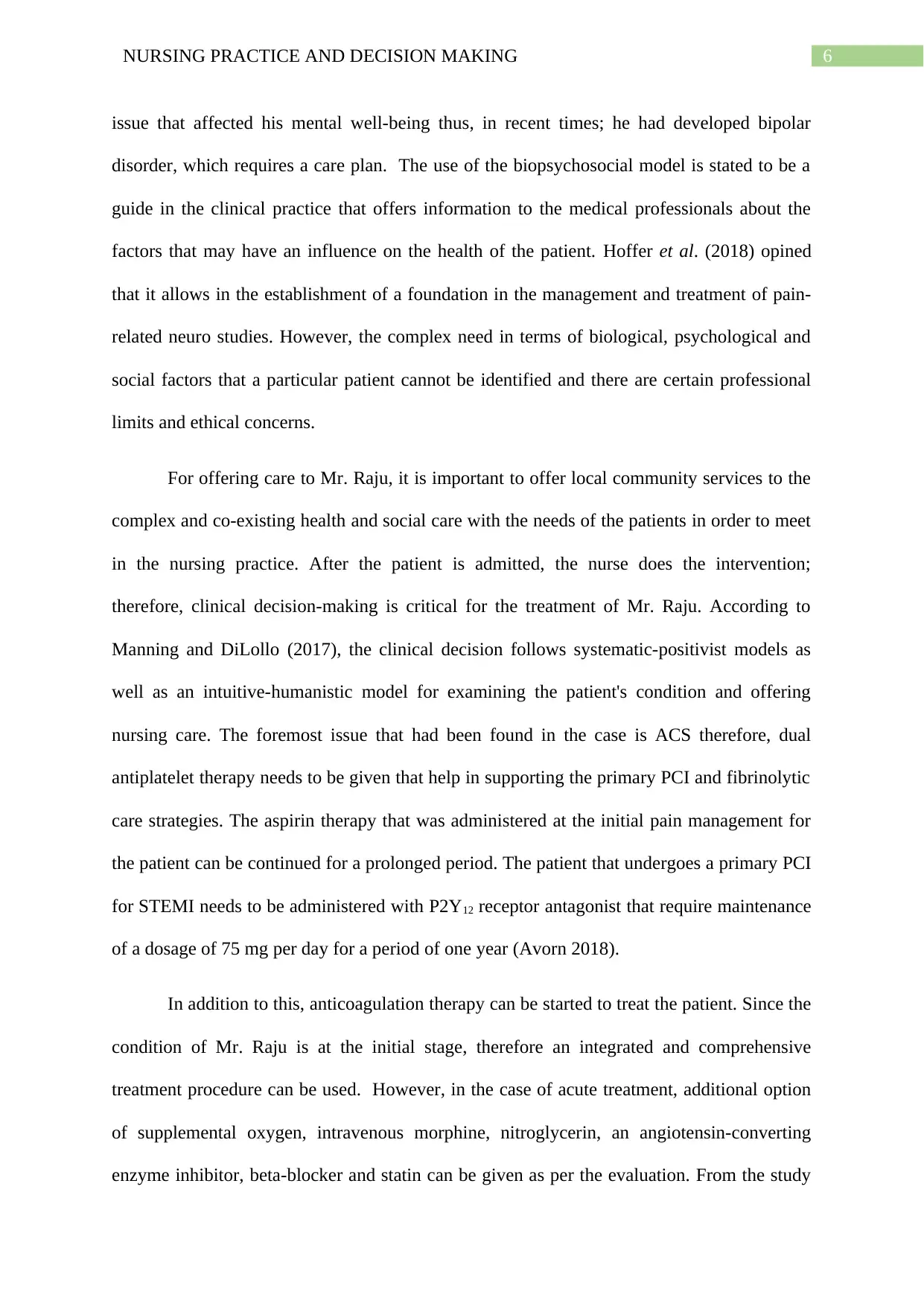
6NURSING PRACTICE AND DECISION MAKING
issue that affected his mental well-being thus, in recent times; he had developed bipolar
disorder, which requires a care plan. The use of the biopsychosocial model is stated to be a
guide in the clinical practice that offers information to the medical professionals about the
factors that may have an influence on the health of the patient. Hoffer et al. (2018) opined
that it allows in the establishment of a foundation in the management and treatment of pain-
related neuro studies. However, the complex need in terms of biological, psychological and
social factors that a particular patient cannot be identified and there are certain professional
limits and ethical concerns.
For offering care to Mr. Raju, it is important to offer local community services to the
complex and co-existing health and social care with the needs of the patients in order to meet
in the nursing practice. After the patient is admitted, the nurse does the intervention;
therefore, clinical decision-making is critical for the treatment of Mr. Raju. According to
Manning and DiLollo (2017), the clinical decision follows systematic-positivist models as
well as an intuitive-humanistic model for examining the patient's condition and offering
nursing care. The foremost issue that had been found in the case is ACS therefore, dual
antiplatelet therapy needs to be given that help in supporting the primary PCI and fibrinolytic
care strategies. The aspirin therapy that was administered at the initial pain management for
the patient can be continued for a prolonged period. The patient that undergoes a primary PCI
for STEMI needs to be administered with P2Y12 receptor antagonist that require maintenance
of a dosage of 75 mg per day for a period of one year (Avorn 2018).
In addition to this, anticoagulation therapy can be started to treat the patient. Since the
condition of Mr. Raju is at the initial stage, therefore an integrated and comprehensive
treatment procedure can be used. However, in the case of acute treatment, additional option
of supplemental oxygen, intravenous morphine, nitroglycerin, an angiotensin-converting
enzyme inhibitor, beta-blocker and statin can be given as per the evaluation. From the study
issue that affected his mental well-being thus, in recent times; he had developed bipolar
disorder, which requires a care plan. The use of the biopsychosocial model is stated to be a
guide in the clinical practice that offers information to the medical professionals about the
factors that may have an influence on the health of the patient. Hoffer et al. (2018) opined
that it allows in the establishment of a foundation in the management and treatment of pain-
related neuro studies. However, the complex need in terms of biological, psychological and
social factors that a particular patient cannot be identified and there are certain professional
limits and ethical concerns.
For offering care to Mr. Raju, it is important to offer local community services to the
complex and co-existing health and social care with the needs of the patients in order to meet
in the nursing practice. After the patient is admitted, the nurse does the intervention;
therefore, clinical decision-making is critical for the treatment of Mr. Raju. According to
Manning and DiLollo (2017), the clinical decision follows systematic-positivist models as
well as an intuitive-humanistic model for examining the patient's condition and offering
nursing care. The foremost issue that had been found in the case is ACS therefore, dual
antiplatelet therapy needs to be given that help in supporting the primary PCI and fibrinolytic
care strategies. The aspirin therapy that was administered at the initial pain management for
the patient can be continued for a prolonged period. The patient that undergoes a primary PCI
for STEMI needs to be administered with P2Y12 receptor antagonist that require maintenance
of a dosage of 75 mg per day for a period of one year (Avorn 2018).
In addition to this, anticoagulation therapy can be started to treat the patient. Since the
condition of Mr. Raju is at the initial stage, therefore an integrated and comprehensive
treatment procedure can be used. However, in the case of acute treatment, additional option
of supplemental oxygen, intravenous morphine, nitroglycerin, an angiotensin-converting
enzyme inhibitor, beta-blocker and statin can be given as per the evaluation. From the study
Paraphrase This Document
Need a fresh take? Get an instant paraphrase of this document with our AI Paraphraser
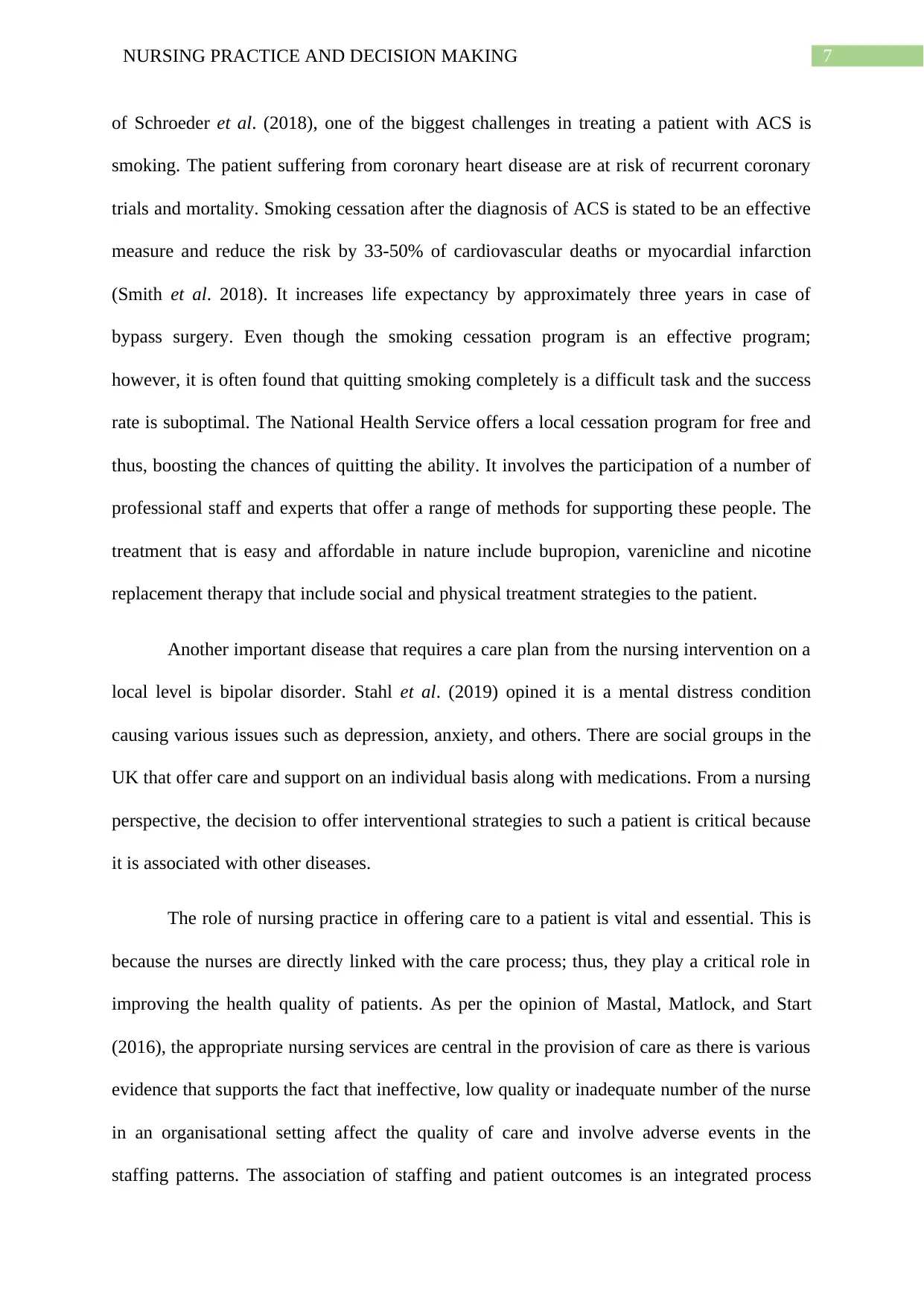
7NURSING PRACTICE AND DECISION MAKING
of Schroeder et al. (2018), one of the biggest challenges in treating a patient with ACS is
smoking. The patient suffering from coronary heart disease are at risk of recurrent coronary
trials and mortality. Smoking cessation after the diagnosis of ACS is stated to be an effective
measure and reduce the risk by 33-50% of cardiovascular deaths or myocardial infarction
(Smith et al. 2018). It increases life expectancy by approximately three years in case of
bypass surgery. Even though the smoking cessation program is an effective program;
however, it is often found that quitting smoking completely is a difficult task and the success
rate is suboptimal. The National Health Service offers a local cessation program for free and
thus, boosting the chances of quitting the ability. It involves the participation of a number of
professional staff and experts that offer a range of methods for supporting these people. The
treatment that is easy and affordable in nature include bupropion, varenicline and nicotine
replacement therapy that include social and physical treatment strategies to the patient.
Another important disease that requires a care plan from the nursing intervention on a
local level is bipolar disorder. Stahl et al. (2019) opined it is a mental distress condition
causing various issues such as depression, anxiety, and others. There are social groups in the
UK that offer care and support on an individual basis along with medications. From a nursing
perspective, the decision to offer interventional strategies to such a patient is critical because
it is associated with other diseases.
The role of nursing practice in offering care to a patient is vital and essential. This is
because the nurses are directly linked with the care process; thus, they play a critical role in
improving the health quality of patients. As per the opinion of Mastal, Matlock, and Start
(2016), the appropriate nursing services are central in the provision of care as there is various
evidence that supports the fact that ineffective, low quality or inadequate number of the nurse
in an organisational setting affect the quality of care and involve adverse events in the
staffing patterns. The association of staffing and patient outcomes is an integrated process
of Schroeder et al. (2018), one of the biggest challenges in treating a patient with ACS is
smoking. The patient suffering from coronary heart disease are at risk of recurrent coronary
trials and mortality. Smoking cessation after the diagnosis of ACS is stated to be an effective
measure and reduce the risk by 33-50% of cardiovascular deaths or myocardial infarction
(Smith et al. 2018). It increases life expectancy by approximately three years in case of
bypass surgery. Even though the smoking cessation program is an effective program;
however, it is often found that quitting smoking completely is a difficult task and the success
rate is suboptimal. The National Health Service offers a local cessation program for free and
thus, boosting the chances of quitting the ability. It involves the participation of a number of
professional staff and experts that offer a range of methods for supporting these people. The
treatment that is easy and affordable in nature include bupropion, varenicline and nicotine
replacement therapy that include social and physical treatment strategies to the patient.
Another important disease that requires a care plan from the nursing intervention on a
local level is bipolar disorder. Stahl et al. (2019) opined it is a mental distress condition
causing various issues such as depression, anxiety, and others. There are social groups in the
UK that offer care and support on an individual basis along with medications. From a nursing
perspective, the decision to offer interventional strategies to such a patient is critical because
it is associated with other diseases.
The role of nursing practice in offering care to a patient is vital and essential. This is
because the nurses are directly linked with the care process; thus, they play a critical role in
improving the health quality of patients. As per the opinion of Mastal, Matlock, and Start
(2016), the appropriate nursing services are central in the provision of care as there is various
evidence that supports the fact that ineffective, low quality or inadequate number of the nurse
in an organisational setting affect the quality of care and involve adverse events in the
staffing patterns. The association of staffing and patient outcomes is an integrated process
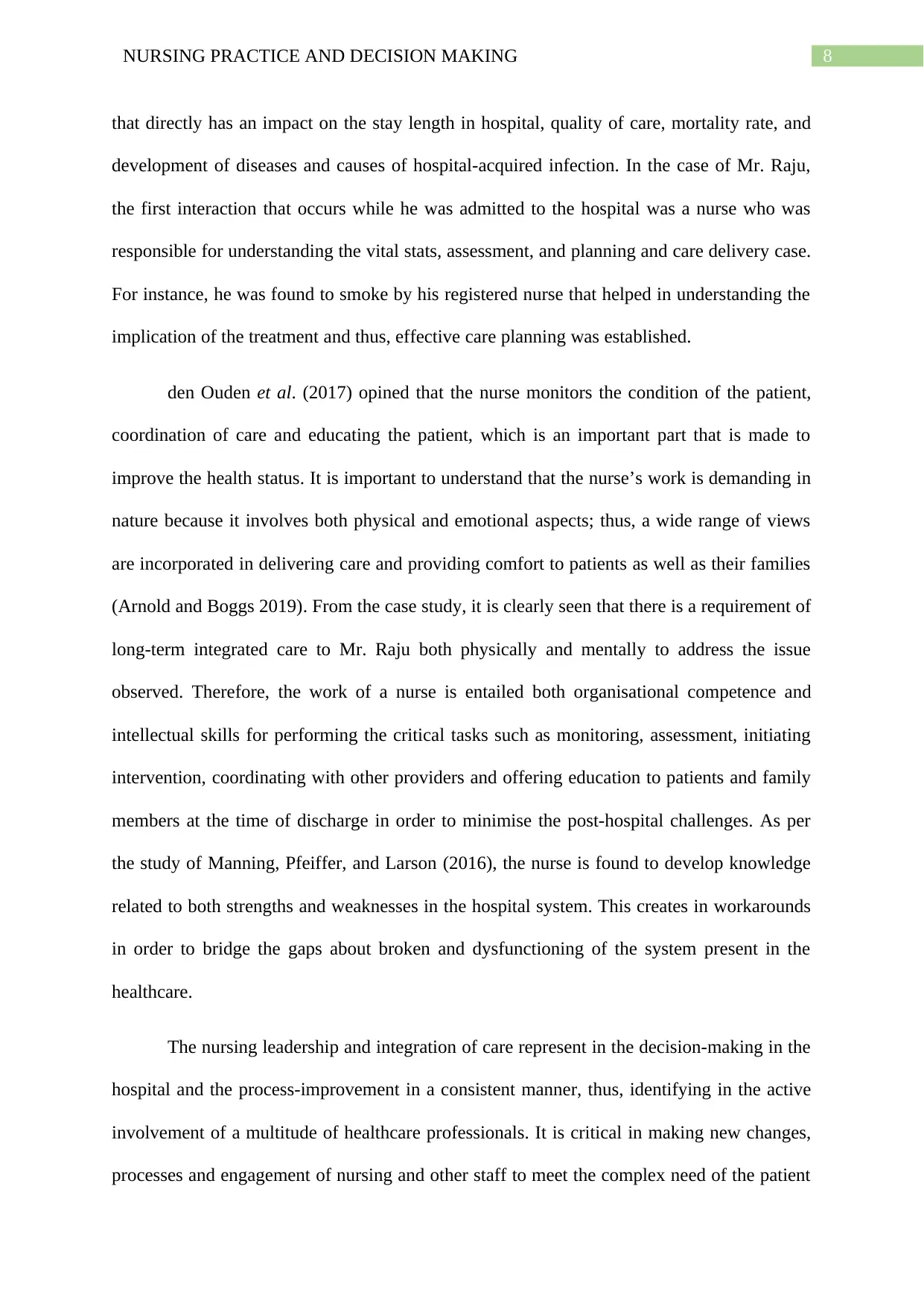
8NURSING PRACTICE AND DECISION MAKING
that directly has an impact on the stay length in hospital, quality of care, mortality rate, and
development of diseases and causes of hospital-acquired infection. In the case of Mr. Raju,
the first interaction that occurs while he was admitted to the hospital was a nurse who was
responsible for understanding the vital stats, assessment, and planning and care delivery case.
For instance, he was found to smoke by his registered nurse that helped in understanding the
implication of the treatment and thus, effective care planning was established.
den Ouden et al. (2017) opined that the nurse monitors the condition of the patient,
coordination of care and educating the patient, which is an important part that is made to
improve the health status. It is important to understand that the nurse’s work is demanding in
nature because it involves both physical and emotional aspects; thus, a wide range of views
are incorporated in delivering care and providing comfort to patients as well as their families
(Arnold and Boggs 2019). From the case study, it is clearly seen that there is a requirement of
long-term integrated care to Mr. Raju both physically and mentally to address the issue
observed. Therefore, the work of a nurse is entailed both organisational competence and
intellectual skills for performing the critical tasks such as monitoring, assessment, initiating
intervention, coordinating with other providers and offering education to patients and family
members at the time of discharge in order to minimise the post-hospital challenges. As per
the study of Manning, Pfeiffer, and Larson (2016), the nurse is found to develop knowledge
related to both strengths and weaknesses in the hospital system. This creates in workarounds
in order to bridge the gaps about broken and dysfunctioning of the system present in the
healthcare.
The nursing leadership and integration of care represent in the decision-making in the
hospital and the process-improvement in a consistent manner, thus, identifying in the active
involvement of a multitude of healthcare professionals. It is critical in making new changes,
processes and engagement of nursing and other staff to meet the complex need of the patient
that directly has an impact on the stay length in hospital, quality of care, mortality rate, and
development of diseases and causes of hospital-acquired infection. In the case of Mr. Raju,
the first interaction that occurs while he was admitted to the hospital was a nurse who was
responsible for understanding the vital stats, assessment, and planning and care delivery case.
For instance, he was found to smoke by his registered nurse that helped in understanding the
implication of the treatment and thus, effective care planning was established.
den Ouden et al. (2017) opined that the nurse monitors the condition of the patient,
coordination of care and educating the patient, which is an important part that is made to
improve the health status. It is important to understand that the nurse’s work is demanding in
nature because it involves both physical and emotional aspects; thus, a wide range of views
are incorporated in delivering care and providing comfort to patients as well as their families
(Arnold and Boggs 2019). From the case study, it is clearly seen that there is a requirement of
long-term integrated care to Mr. Raju both physically and mentally to address the issue
observed. Therefore, the work of a nurse is entailed both organisational competence and
intellectual skills for performing the critical tasks such as monitoring, assessment, initiating
intervention, coordinating with other providers and offering education to patients and family
members at the time of discharge in order to minimise the post-hospital challenges. As per
the study of Manning, Pfeiffer, and Larson (2016), the nurse is found to develop knowledge
related to both strengths and weaknesses in the hospital system. This creates in workarounds
in order to bridge the gaps about broken and dysfunctioning of the system present in the
healthcare.
The nursing leadership and integration of care represent in the decision-making in the
hospital and the process-improvement in a consistent manner, thus, identifying in the active
involvement of a multitude of healthcare professionals. It is critical in making new changes,
processes and engagement of nursing and other staff to meet the complex need of the patient
⊘ This is a preview!⊘
Do you want full access?
Subscribe today to unlock all pages.

Trusted by 1+ million students worldwide
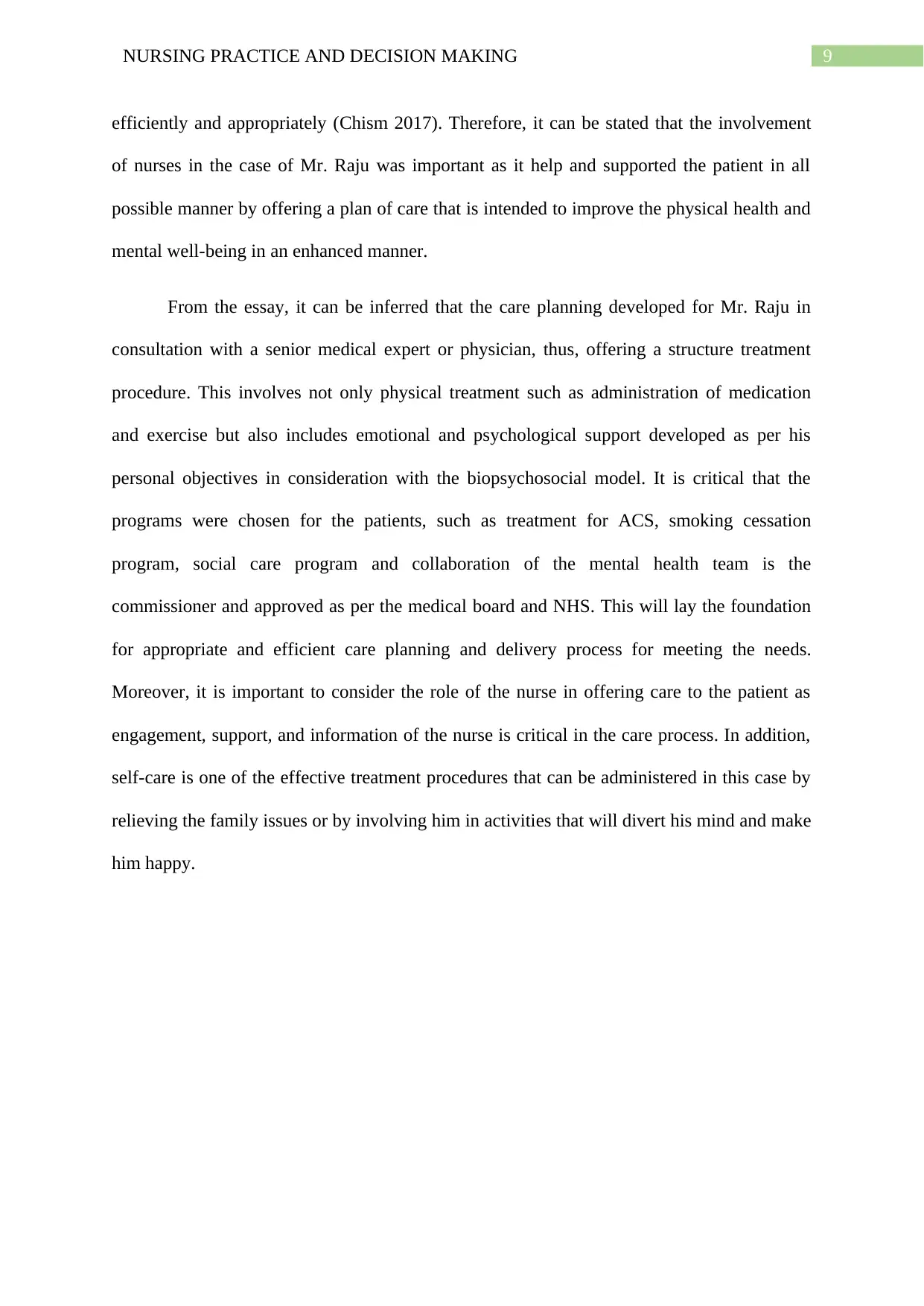
9NURSING PRACTICE AND DECISION MAKING
efficiently and appropriately (Chism 2017). Therefore, it can be stated that the involvement
of nurses in the case of Mr. Raju was important as it help and supported the patient in all
possible manner by offering a plan of care that is intended to improve the physical health and
mental well-being in an enhanced manner.
From the essay, it can be inferred that the care planning developed for Mr. Raju in
consultation with a senior medical expert or physician, thus, offering a structure treatment
procedure. This involves not only physical treatment such as administration of medication
and exercise but also includes emotional and psychological support developed as per his
personal objectives in consideration with the biopsychosocial model. It is critical that the
programs were chosen for the patients, such as treatment for ACS, smoking cessation
program, social care program and collaboration of the mental health team is the
commissioner and approved as per the medical board and NHS. This will lay the foundation
for appropriate and efficient care planning and delivery process for meeting the needs.
Moreover, it is important to consider the role of the nurse in offering care to the patient as
engagement, support, and information of the nurse is critical in the care process. In addition,
self-care is one of the effective treatment procedures that can be administered in this case by
relieving the family issues or by involving him in activities that will divert his mind and make
him happy.
efficiently and appropriately (Chism 2017). Therefore, it can be stated that the involvement
of nurses in the case of Mr. Raju was important as it help and supported the patient in all
possible manner by offering a plan of care that is intended to improve the physical health and
mental well-being in an enhanced manner.
From the essay, it can be inferred that the care planning developed for Mr. Raju in
consultation with a senior medical expert or physician, thus, offering a structure treatment
procedure. This involves not only physical treatment such as administration of medication
and exercise but also includes emotional and psychological support developed as per his
personal objectives in consideration with the biopsychosocial model. It is critical that the
programs were chosen for the patients, such as treatment for ACS, smoking cessation
program, social care program and collaboration of the mental health team is the
commissioner and approved as per the medical board and NHS. This will lay the foundation
for appropriate and efficient care planning and delivery process for meeting the needs.
Moreover, it is important to consider the role of the nurse in offering care to the patient as
engagement, support, and information of the nurse is critical in the care process. In addition,
self-care is one of the effective treatment procedures that can be administered in this case by
relieving the family issues or by involving him in activities that will divert his mind and make
him happy.
Paraphrase This Document
Need a fresh take? Get an instant paraphrase of this document with our AI Paraphraser
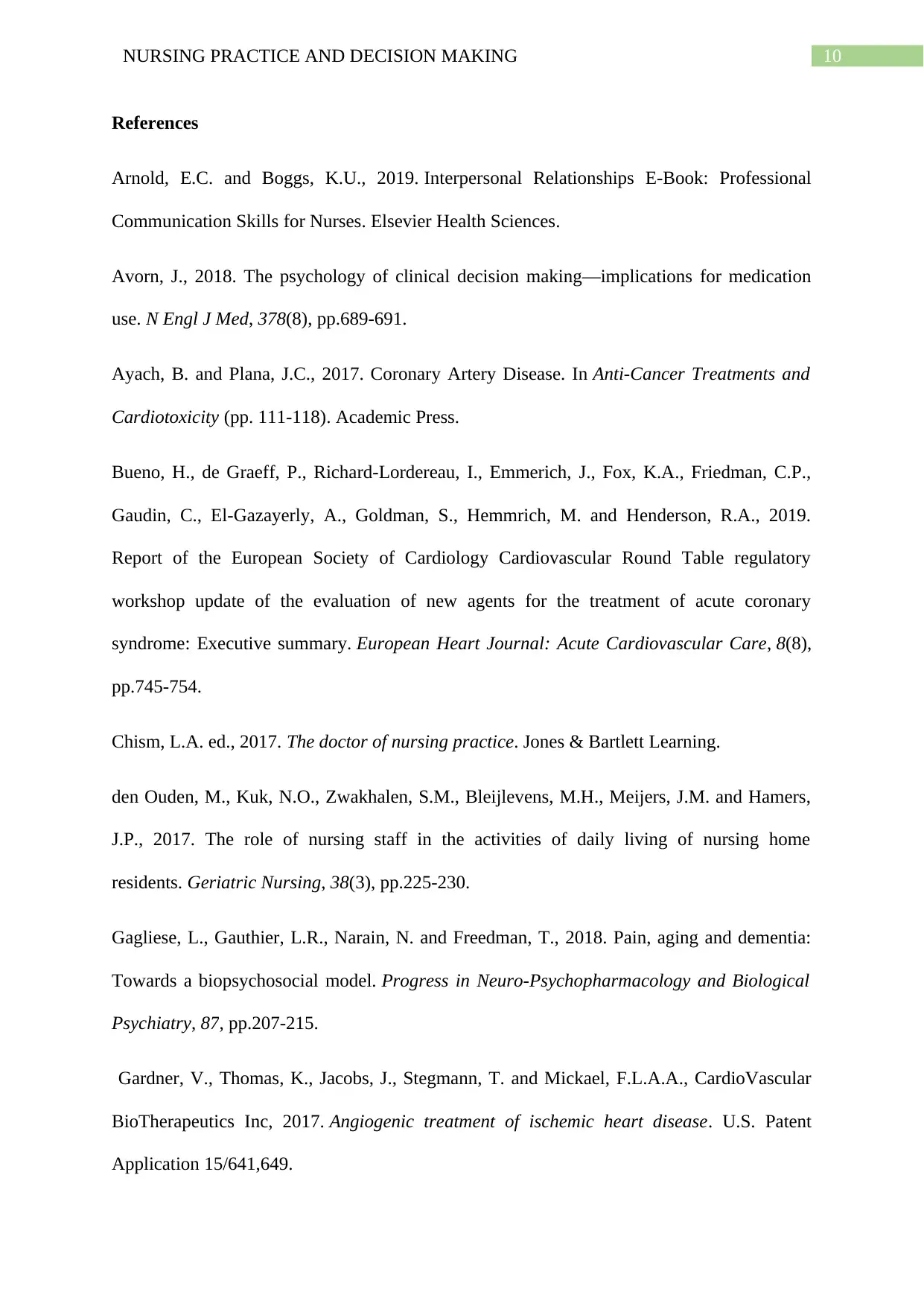
10NURSING PRACTICE AND DECISION MAKING
References
Arnold, E.C. and Boggs, K.U., 2019. Interpersonal Relationships E-Book: Professional
Communication Skills for Nurses. Elsevier Health Sciences.
Avorn, J., 2018. The psychology of clinical decision making—implications for medication
use. N Engl J Med, 378(8), pp.689-691.
Ayach, B. and Plana, J.C., 2017. Coronary Artery Disease. In Anti-Cancer Treatments and
Cardiotoxicity (pp. 111-118). Academic Press.
Bueno, H., de Graeff, P., Richard-Lordereau, I., Emmerich, J., Fox, K.A., Friedman, C.P.,
Gaudin, C., El-Gazayerly, A., Goldman, S., Hemmrich, M. and Henderson, R.A., 2019.
Report of the European Society of Cardiology Cardiovascular Round Table regulatory
workshop update of the evaluation of new agents for the treatment of acute coronary
syndrome: Executive summary. European Heart Journal: Acute Cardiovascular Care, 8(8),
pp.745-754.
Chism, L.A. ed., 2017. The doctor of nursing practice. Jones & Bartlett Learning.
den Ouden, M., Kuk, N.O., Zwakhalen, S.M., Bleijlevens, M.H., Meijers, J.M. and Hamers,
J.P., 2017. The role of nursing staff in the activities of daily living of nursing home
residents. Geriatric Nursing, 38(3), pp.225-230.
Gagliese, L., Gauthier, L.R., Narain, N. and Freedman, T., 2018. Pain, aging and dementia:
Towards a biopsychosocial model. Progress in Neuro-Psychopharmacology and Biological
Psychiatry, 87, pp.207-215.
Gardner, V., Thomas, K., Jacobs, J., Stegmann, T. and Mickael, F.L.A.A., CardioVascular
BioTherapeutics Inc, 2017. Angiogenic treatment of ischemic heart disease. U.S. Patent
Application 15/641,649.
References
Arnold, E.C. and Boggs, K.U., 2019. Interpersonal Relationships E-Book: Professional
Communication Skills for Nurses. Elsevier Health Sciences.
Avorn, J., 2018. The psychology of clinical decision making—implications for medication
use. N Engl J Med, 378(8), pp.689-691.
Ayach, B. and Plana, J.C., 2017. Coronary Artery Disease. In Anti-Cancer Treatments and
Cardiotoxicity (pp. 111-118). Academic Press.
Bueno, H., de Graeff, P., Richard-Lordereau, I., Emmerich, J., Fox, K.A., Friedman, C.P.,
Gaudin, C., El-Gazayerly, A., Goldman, S., Hemmrich, M. and Henderson, R.A., 2019.
Report of the European Society of Cardiology Cardiovascular Round Table regulatory
workshop update of the evaluation of new agents for the treatment of acute coronary
syndrome: Executive summary. European Heart Journal: Acute Cardiovascular Care, 8(8),
pp.745-754.
Chism, L.A. ed., 2017. The doctor of nursing practice. Jones & Bartlett Learning.
den Ouden, M., Kuk, N.O., Zwakhalen, S.M., Bleijlevens, M.H., Meijers, J.M. and Hamers,
J.P., 2017. The role of nursing staff in the activities of daily living of nursing home
residents. Geriatric Nursing, 38(3), pp.225-230.
Gagliese, L., Gauthier, L.R., Narain, N. and Freedman, T., 2018. Pain, aging and dementia:
Towards a biopsychosocial model. Progress in Neuro-Psychopharmacology and Biological
Psychiatry, 87, pp.207-215.
Gardner, V., Thomas, K., Jacobs, J., Stegmann, T. and Mickael, F.L.A.A., CardioVascular
BioTherapeutics Inc, 2017. Angiogenic treatment of ischemic heart disease. U.S. Patent
Application 15/641,649.
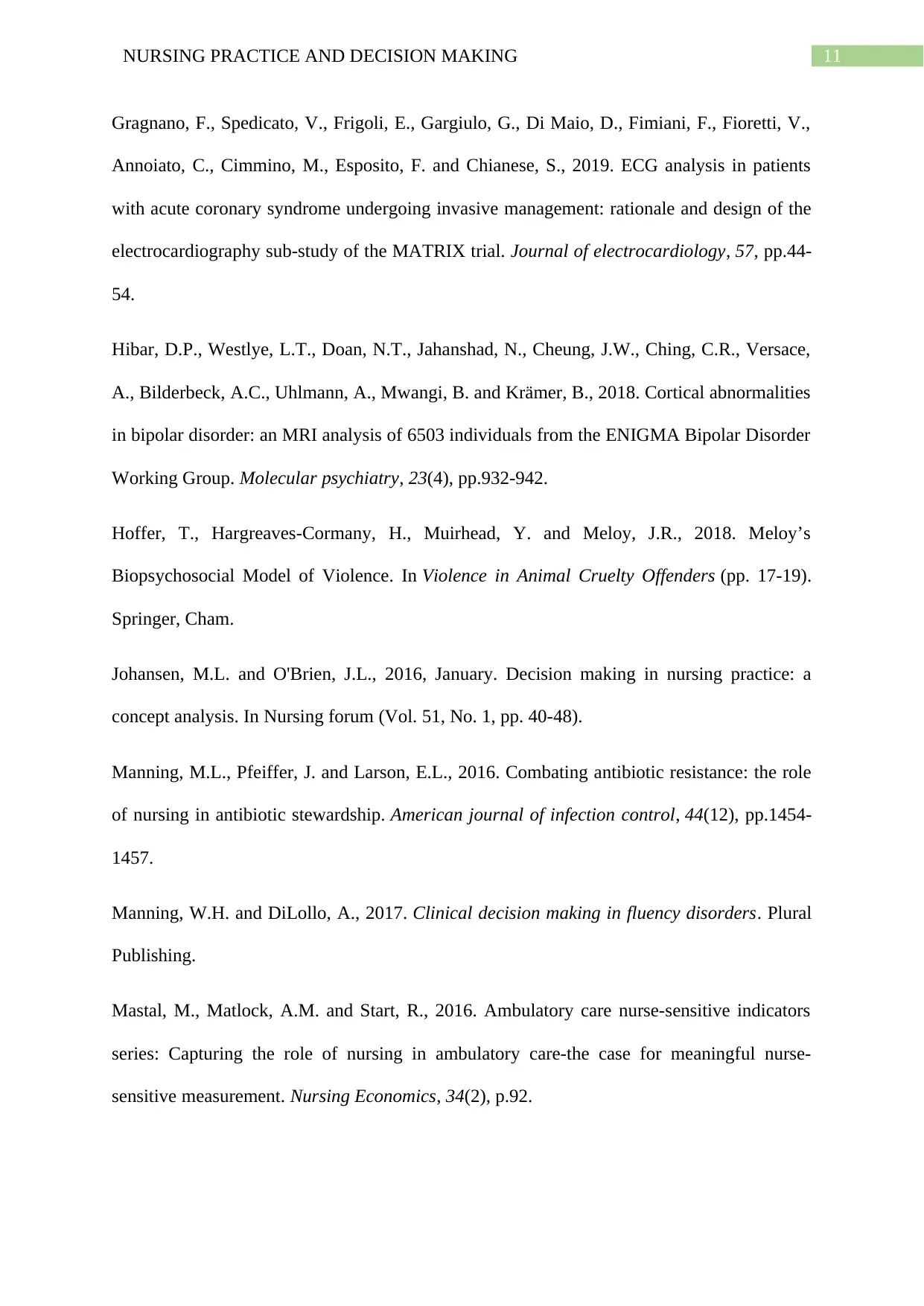
11NURSING PRACTICE AND DECISION MAKING
Gragnano, F., Spedicato, V., Frigoli, E., Gargiulo, G., Di Maio, D., Fimiani, F., Fioretti, V.,
Annoiato, C., Cimmino, M., Esposito, F. and Chianese, S., 2019. ECG analysis in patients
with acute coronary syndrome undergoing invasive management: rationale and design of the
electrocardiography sub-study of the MATRIX trial. Journal of electrocardiology, 57, pp.44-
54.
Hibar, D.P., Westlye, L.T., Doan, N.T., Jahanshad, N., Cheung, J.W., Ching, C.R., Versace,
A., Bilderbeck, A.C., Uhlmann, A., Mwangi, B. and Krämer, B., 2018. Cortical abnormalities
in bipolar disorder: an MRI analysis of 6503 individuals from the ENIGMA Bipolar Disorder
Working Group. Molecular psychiatry, 23(4), pp.932-942.
Hoffer, T., Hargreaves-Cormany, H., Muirhead, Y. and Meloy, J.R., 2018. Meloy’s
Biopsychosocial Model of Violence. In Violence in Animal Cruelty Offenders (pp. 17-19).
Springer, Cham.
Johansen, M.L. and O'Brien, J.L., 2016, January. Decision making in nursing practice: a
concept analysis. In Nursing forum (Vol. 51, No. 1, pp. 40-48).
Manning, M.L., Pfeiffer, J. and Larson, E.L., 2016. Combating antibiotic resistance: the role
of nursing in antibiotic stewardship. American journal of infection control, 44(12), pp.1454-
1457.
Manning, W.H. and DiLollo, A., 2017. Clinical decision making in fluency disorders. Plural
Publishing.
Mastal, M., Matlock, A.M. and Start, R., 2016. Ambulatory care nurse-sensitive indicators
series: Capturing the role of nursing in ambulatory care-the case for meaningful nurse-
sensitive measurement. Nursing Economics, 34(2), p.92.
Gragnano, F., Spedicato, V., Frigoli, E., Gargiulo, G., Di Maio, D., Fimiani, F., Fioretti, V.,
Annoiato, C., Cimmino, M., Esposito, F. and Chianese, S., 2019. ECG analysis in patients
with acute coronary syndrome undergoing invasive management: rationale and design of the
electrocardiography sub-study of the MATRIX trial. Journal of electrocardiology, 57, pp.44-
54.
Hibar, D.P., Westlye, L.T., Doan, N.T., Jahanshad, N., Cheung, J.W., Ching, C.R., Versace,
A., Bilderbeck, A.C., Uhlmann, A., Mwangi, B. and Krämer, B., 2018. Cortical abnormalities
in bipolar disorder: an MRI analysis of 6503 individuals from the ENIGMA Bipolar Disorder
Working Group. Molecular psychiatry, 23(4), pp.932-942.
Hoffer, T., Hargreaves-Cormany, H., Muirhead, Y. and Meloy, J.R., 2018. Meloy’s
Biopsychosocial Model of Violence. In Violence in Animal Cruelty Offenders (pp. 17-19).
Springer, Cham.
Johansen, M.L. and O'Brien, J.L., 2016, January. Decision making in nursing practice: a
concept analysis. In Nursing forum (Vol. 51, No. 1, pp. 40-48).
Manning, M.L., Pfeiffer, J. and Larson, E.L., 2016. Combating antibiotic resistance: the role
of nursing in antibiotic stewardship. American journal of infection control, 44(12), pp.1454-
1457.
Manning, W.H. and DiLollo, A., 2017. Clinical decision making in fluency disorders. Plural
Publishing.
Mastal, M., Matlock, A.M. and Start, R., 2016. Ambulatory care nurse-sensitive indicators
series: Capturing the role of nursing in ambulatory care-the case for meaningful nurse-
sensitive measurement. Nursing Economics, 34(2), p.92.
⊘ This is a preview!⊘
Do you want full access?
Subscribe today to unlock all pages.

Trusted by 1+ million students worldwide
1 out of 14
Related Documents
Your All-in-One AI-Powered Toolkit for Academic Success.
+13062052269
info@desklib.com
Available 24*7 on WhatsApp / Email
![[object Object]](/_next/static/media/star-bottom.7253800d.svg)
Unlock your academic potential
Copyright © 2020–2025 A2Z Services. All Rights Reserved. Developed and managed by ZUCOL.





